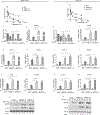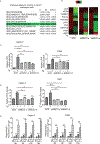MUC1 oncoprotein mitigates ER stress via CDA-mediated reprogramming of pyrimidine metabolism
- PMID: 32103170
- PMCID: PMC7165067
- DOI: 10.1038/s41388-020-1225-4
MUC1 oncoprotein mitigates ER stress via CDA-mediated reprogramming of pyrimidine metabolism
Abstract
The Mucin 1 (MUC1) protein is overexpressed in various cancers and mediates chemotherapy resistance. However, the mechanism is not fully understood. Given that most chemotherapeutic drugs disrupt ER homeostasis as part of their toxicity, and MUC1 expression is regulated by proteins involved in ER homeostasis, we investigated the link between MUC1 and ER homeostasis. MUC1 knockdown in pancreatic cancer cells enhanced unfolded protein response (UPR) signaling and cell death upon ER stress induction. Transcriptomic analysis revealed alterations in the pyrimidine metabolic pathway and cytidine deaminase (CDA). ChIP and CDA activity assays showed that MUC1 occupied CDA gene promoter upon ER stress induction correlating with increased CDA expression and activity in MUC1-expressing cells as compared with MUC1 knockdown cells. Inhibition of either the CDA or pyrimidine metabolic pathway diminished survival in MUC1-expressing cancer cells upon ER stress induction. Metabolomic analysis demonstrated that MUC1-mediated CDA activity corresponded to deoxycytidine to deoxyuridine metabolic reprogramming upon ER stress induction. The resulting increase in deoxyuridine mitigated ER stress-induced cytotoxicity. In addition, given (1) the established roles of MUC1 in protecting cells against reactive oxygen species (ROS) insults, (2) ER stress-generated ROS further promote ER stress and (3) the emerging anti-oxidant property of deoxyuridine, we further investigated if MUC1 regulated ER stress by a deoxyuridine-mediated modulation of ROS levels. We observed that deoxyuridine could abrogate ROS-induced ER stress to promote cancer cell survival. Taken together, our findings demonstrate a novel MUC1-CDA axis of the adaptive UPR that provides survival advantage upon ER stress induction.
Conflict of interest statement
Figures






Similar articles
-
Contribution of Cytidine Deaminase to Thymidylate Biosynthesis in Trypanosoma brucei: Intracellular Localization and Properties of the Enzyme.mSphere. 2019 Aug 7;4(4):e00374-19. doi: 10.1128/mSphere.00374-19. mSphere. 2019. PMID: 31391279 Free PMC article.
-
MUC1-Mediated Metabolic Alterations Regulate Response to Radiotherapy in Pancreatic Cancer.Clin Cancer Res. 2017 Oct 1;23(19):5881-5891. doi: 10.1158/1078-0432.CCR-17-1151. Epub 2017 Jul 18. Clin Cancer Res. 2017. PMID: 28720669 Free PMC article.
-
Cytidine deaminase-dependent mitochondrial biogenesis as a potential vulnerability in pancreatic cancer cells.Commun Biol. 2024 Aug 30;7(1):1065. doi: 10.1038/s42003-024-06760-y. Commun Biol. 2024. PMID: 39215188 Free PMC article.
-
Endoplasmic reticulum stress signaling: the microRNA connection.Am J Physiol Cell Physiol. 2013 Jun 15;304(12):C1117-26. doi: 10.1152/ajpcell.00061.2013. Epub 2013 Mar 20. Am J Physiol Cell Physiol. 2013. PMID: 23515532 Review.
-
Endoplasmic reticulum stress associated responses in cancer.Biochim Biophys Acta. 2014 Oct;1843(10):2143-9. doi: 10.1016/j.bbamcr.2014.01.012. Epub 2014 Jan 16. Biochim Biophys Acta. 2014. PMID: 24440276 Review.
Cited by
-
DHODH inhibition enhances the efficacy of immune checkpoint blockade by increasing cancer cell antigen presentation.Elife. 2024 Jul 8;12:RP87292. doi: 10.7554/eLife.87292. Elife. 2024. PMID: 38973593 Free PMC article.
-
The MUC1-HIF-1α signaling axis regulates pancreatic cancer pathogenesis through polyamine metabolism remodeling.Proc Natl Acad Sci U S A. 2024 Apr 2;121(14):e2315509121. doi: 10.1073/pnas.2315509121. Epub 2024 Mar 28. Proc Natl Acad Sci U S A. 2024. PMID: 38547055 Free PMC article.
-
Targets (Metabolic Mediators) of Therapeutic Importance in Pancreatic Ductal Adenocarcinoma.Int J Mol Sci. 2020 Nov 12;21(22):8502. doi: 10.3390/ijms21228502. Int J Mol Sci. 2020. PMID: 33198082 Free PMC article. Review.
-
Nucleotide metabolism: a pan-cancer metabolic dependency.Nat Rev Cancer. 2023 May;23(5):275-294. doi: 10.1038/s41568-023-00557-7. Epub 2023 Mar 27. Nat Rev Cancer. 2023. PMID: 36973407 Free PMC article. Review.
-
Activation of Vitamin D/VDR Signaling Reverses Gemcitabine Resistance of Pancreatic Cancer Cells Through Inhibition of MUC1 Expression.Dig Dis Sci. 2023 Jul;68(7):3043-3058. doi: 10.1007/s10620-023-07931-3. Epub 2023 Apr 18. Dig Dis Sci. 2023. PMID: 37071246 Free PMC article.
References
-
- Berridge MJ, Bootman MD, Roderick HL. Calcium signalling: dynamics, homeostasis and remodelling. Nature reviews Molecular cell biology. 2003;4(7):517–29. - PubMed
-
- Ikonen E Cellular cholesterol trafficking and compartmentalization. Nature reviews Molecular cell biology. 2008;9(2):125–38. - PubMed
-
- Jun HS, Lee YM, Cheung YY, McDermott DH, Murphy PM, De Ravin SS, et al. Lack of glucose recycling between endoplasmic reticulum and cytoplasm underlies cellular dysfunction in glucose-6-phosphatase-beta-deficient neutrophils in a congenital neutropenia syndrome. Blood. 2010;116(15):2783–92. - PMC - PubMed
Publication types
MeSH terms
Substances
Grants and funding
LinkOut - more resources
Full Text Sources
Medical
Research Materials
Miscellaneous

